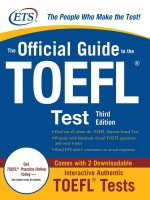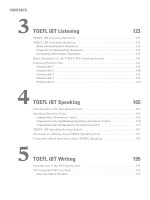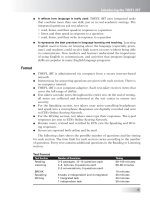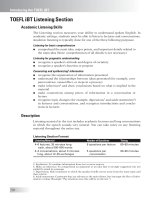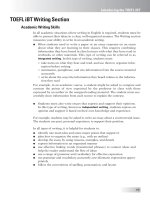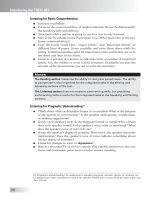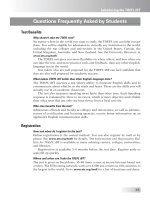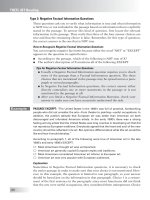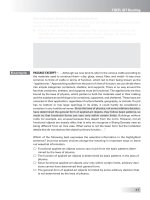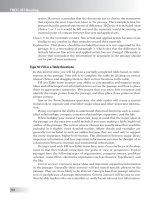The official guide to the toefl ibt third edition part 8 docx
Bạn đang xem bản rút gọn của tài liệu. Xem và tải ngay bản đầy đủ của tài liệu tại đây (97.74 KB, 7 trang )
TOEFL iBT Reading
Type 2: Negative Factual Information Questions
These questions ask you to verify what information is true and what information
is NOT true or not included in the passage based on information that is explicitly
stated in the passage. To answer this kind of question, first locate the relevant
information in the passage. Then verify that three of the four answer choices are
true and that the remaining choice is false. Remember, for this type of question,
the correct answer is the one that is NOT true.
How to Recognize Negative Factual Information Questions
You can recognize negative fact items because either the word “NOT” or “EXCEPT”
appears in the question in capital letters.
b
According to the passage, which of the following is NOT true of X?
b
The author’s description of X mentions all of the following EXCEPT
Tips for Negative Factual Information Questions
b
Usually a Negative Factual Information question requires you to check
more of the passage than a Factual Information question. The three
choices that are mentioned in the passage may be spread across a para-
graph or several paragraphs.
b
In Negative Factual Information questions, the correct answer either
directly contradicts one or more statements in the passage or is not
mentioned in the passage at all.
b
After you finish a Negative Factual Information Question, check your
answer to make sure you have accurately understood the task.
Example
PASSAGE EXCERPT: “The United States in the 1800’s was full of practical, hardworking
people who did not consider the arts—from theater to painting—useful occupations. In
addition, the public’s attitude that European art was better than American art both
discouraged and infuriated American artists. In the early 1900’s there was a strong
feeling among artists that the United States was long overdue in developing art that did
not reproduce European traditions. Everybody agreed that the heart and soul of the new
country should be reflected in its art. But opinions differed about what this art would be
like and how it would develop.”
According to paragraph 1, all of the following were true of American art in the late
1800’s and early 1900’s EXCEPT:
ɕ
Most Americans thought art was unimportant.
ɕ
American art generally copied European styles and traditions.
ɕ
Most Americans considered American art inferior to European art.
ɕ
American art was very popular with European audiences.
Explanation
Sometimes in Negative Factual Information questions, it is necessary to check
the entire passage in order to make sure that your choice is not mentioned. How-
ever, in this example, the question is limited to one paragraph, so your answer
should be based just on the information in that paragraph. Choice 1 is a restate-
ment of the first sentence in the paragraph: since most Americans did not think
that the arts were useful occupations, they considered them unimportant. Choice
40
2 makes the same point as the third sentence: “. . . the United States was long
overdue in developing art that did not reproduce European traditions” means
that up to this point in history, American art did reproduce European traditions.
Choice 3 is a restatement of the second sentence in the paragraph: American
artists were frustrated because of “the public’s attitude that European art was bet-
ter than American art. . . .” Choice 4 is not mentioned anywhere in the paragraph.
Because you are asked to identify the choice that is NOT mentioned in the pas-
sage or that contradicts the passage, the correct answer is choice 4.
Type 3: Inference Questions
These questions measure your ability to comprehend an argument or an idea that
is strongly implied but not explicitly stated in the text. For example, if an effect is
cited in the passage, an Inference question might ask about its cause. If a com-
parison is made, an Inference question might ask for the basis of the comparison.
You should think about not only the explicit meaning of the author’s words, but
the logical implications of those words.
How to Recognize Inference Questions
Inference questions will usually include the word infer, suggest, or imply.
b
Which of the following can be inferred about X?
b
The author of the passage implies that X . . .
b
Which of the following can be inferred from paragraph 1 about X?
Tips for Inference Questions
b
Make sure your answer does not contradict the main idea of the passage.
b
Don’t choose an answer just because it seems important or true. The cor-
rect answer must be inferable from the passage.
b
You should be able to defend your choice by pointing to explicitly stated
information in the passage that leads to the inference you have selected.
Example
PASSAGE EXCERPT: “. . . The nineteenth century brought with it a burst of new discov-
eries and inventions that revolutionized the candle industry and made lighting available
to all. In the early-to-mid-nineteenth century, a process was developed to refine tallow
(fat from animals) with alkali and sulfuric acid. The result was a product called stearin.
Stearin is harder and burns longer than unrefined tallow. This breakthrough meant that it
was possible to make tallow candles that would not produce the usual smoke and rancid
odor. Stearins were also derived from palm oils, so vegetable waxes as well as animal
fats could be used to make candles . . . “
Which of the following can be inferred from paragraph 1 about candles before the
nineteenth century?
ɕ
They did not smoke when they were burned.
ɕ
They produced a pleasant odor as they burned.
ɕ
They were not available to all.
ɕ
They contained sulfuric acid.
41
TOEFL iBT Reading
TOEFL iBT Reading
Explanation
In the first sentence from the excerpt the author says that “new discoveries and
inventions” made “lighting available to all.” The only kind of lighting discussed in
the passage is candles. If the new discoveries were important because they made
candles available to all, we can infer that before the discoveries, candles were not
available to everyone. Therefore, choice 3 is an inference about candles we can
make from the passage. Choices 1 and 2 can be eliminated because they explicitly
contradict the passage (“the usual smoke” and “rancid odor”). Choice 4 can be
eliminated because sulfuric acid was first used to make stearin in the nineteenth
century, not before the nineteenth century.
Type 4: Rhetorical Purpose Questions
Rhetoric is the art of speaking or writing effectively. In Factual Information ques-
tions you are asked
what information an author has presented. In Rhetorical
Purpose questions you are asked
why the author has presented a particular piece
of information in a particular place or manner. Rhetorical Purpose questions
ask you to show that you understand the rhetorical function of a statement or
paragraph as it relates to the rest of the passage.
Sometimes you will be asked to identify how one paragraph relates to
another. For instance, the second paragraph may give examples to support a
statement in the first paragraph. The answer choices may be expressed in general
terms, (for example, “a theory is explained and then illustrated”) or in terms that
are specific to the passage. (“The author explains the categories of adaptation to
deserts by mammals and then gives an example.”)
A Rhetorical Purpose question may also ask why the author quotes a certain
person or why the author mentions a particular piece of information (Example:
Why does the author mention “the ability to grasp a pencil”? Correct answer: It is
an example of a motor skill developed by children at 10 to 11 months of age.)
How to Recognize Rhetorical Purpose Questions
These are examples of the way Rhetorical Purpose questions are typically
worded:
b
The author discusses X in paragraph 2 in order to . . .
b
Why does the author mention X?
b
The author uses X as an example of . . .
Tips for Rhetorical Purpose Questions
b
Know the definitions of these words or phrases, which are often used to
describe different kinds of rhetorical purposes: “definition,” “example,”
“to illustrate,” “to explain,” “to contrast,” “to refute,” “to note,” “to criti-
cize,” “function of.”
b
Rhetorical Purpose questions usually do not ask about the overall organ-
ization of the reading passage. Instead, they typically focus on the logi-
cal links between sentences and paragraphs.
42
Example
PASSAGE EXCERPT: “. . . Sensitivity to physical laws is thus an important consideration
for the maker of applied-art objects. It is often taken for granted that this is also true for
the maker of fine-art objects. This assumption misses a significant difference between
the two disciplines. Fine-art objects are not constrained by the laws of physics in the
same way that applied-art objects are. Because their primary purpose is not functional,
they are only limited in terms of the materials used to make them. Sculptures must, for
example, be stable, which requires an understanding of the properties of mass, weight
distribution, and stress. Paintings must have rigid stretchers so that the canvas will be
taut, and the paint must not deteriorate, crack, or discolor. These are problems that must
be overcome by the artist because they tend to intrude upon his or her conception of the
work. For example, in the early Italian Renaissance, bronze statues of horses with a
raised foreleg usually had a cannonball under that hoof. This was done because the
cannonball was needed to support the weight of the leg . . . “
Why does the author discuss the bronze statues of horses created by artists in the
early Italian Renaissance?
ɕ
To provide an example of a problem related to the laws of physics that a fine
artist must overcome
ɕ
To argue that fine artists are unconcerned with the laws of physics
ɕ
To contrast the relative sophistication of modern artists in solving problems re-
lated to the laws of physics
ɕ
To note an exceptional piece of art constructed without the aid of technology
Explanation
You should note that the sentence that first mentions “bronze statues of horses”
begins “For example . . .” The author is giving an example of something he has
introduced earlier in the paragraph. The paragraph overall contrasts how the
constraints of physical laws affect the fine arts differently from applied arts or
crafts. The fine artist is not concerned with making an object that is useful, so he
or she is less constrained than the applied artist. However, because even a fine-
arts object is made of some material, the artist must take into account the physi-
cal properties of the material. In the passage, the author uses the example of the
bronze statues of horses to discuss how artists had to include some support for
the raised foreleg of the horse because of the physical properties of the bronze.
So the correct answer is choice 1.
Type 5: Vocabulary Questions
These questions ask you to identify the meanings of individual words and phrases
as they are used in the reading passage (a word might have more than one mean-
ing, but in the reading passage, only one of those meanings is relevant.) Vocabu-
lary that is tested actually occurs in the passage; there is no “list of words” that
must be tested. Usually a word or phrase is chosen to be tested as a vocabulary
item because understanding that word or phrase is important to understanding a
large or important part of the passage. On the TOEFL iBT, some words in the
passage that are unusual, technical, or have special meanings in the context of
the topic are defined for you. If you click on the word in the passage, a definition
43
TOEFL iBT Reading
TOEFL iBT Reading
will appear in a box. In this book, words of this type are defined at the end of the
passage. Naturally, words that are tested as vocabulary questions are not defined
for you.
How to Recognize Vocabulary Questions
Vocabulary questions are usually easy to identify. You will see one word or phrase
highlighted in the passage. You are then asked a question like this:
b
The word X in the passage is closest in meaning to
In the case of a phrase, the question might be:
b
In stating X, the author means that
Tips for Vocabulary Questions
b
Remember that the question is not just asking the meaning of a word; it
is asking for the meaning as it is used in the passage. Do not choose an
answer just because it can be a correct meaning of the word; under-
stand which meaning the author is using in the passage.
b
Reread the sentence in the passage, substituting the word or phrase you
have chosen. Confirm that the sentence still makes sense in the context
of the whole passage.
Examples
PASSAGE EXCERPT: “In the animal world the task of moving about is fulfilled in many
ways. For some animals locomotion is accomplished by changes in body shape . . .”
The word locomotion in the passage is closest in meaning to
ɕ
evolution
ɕ
movement
ɕ
survival
ɕ
escape
Explanation
Locomotion means “the ability to move from place to place.” In this example, it is
a way of restating the phrase “the task of moving” in the preceding sentence. So
the correct answer is choice 2.
PASSAGE EXCERPT: “Some poisonous snake bites need to be treated immediately or
the victim will suffer paralysis . . .”
In stating that the victim will suffer paralysis the author means that the victim will
ɕ
lose the ability to move
ɕ
become unconscious
ɕ
undergo shock
ɕ
feel great pain
Explanation
In this example, both the words tested from the passage and the possible answers
are phrases. Paralysis means “the inability to move,” so if the poison from a snake
bite causes someone to “suffer paralysis,” that person will “lose the ability to
move.” The correct answer is choice 1.
44
Type 6: Reference Questions
These questions ask you to identify referential relationships between the words in
the passage. Often, the relationship is between a pronoun and its antecedent (the
word to which the pronoun refers). Sometimes other kinds of grammatical refer-
ence are tested (like which or this).
How to Recognize Reference Questions
Reference questions look similar to vocabulary questions. In the passage, one
word or phrase is highlighted. Usually the word is a pronoun. Then you are asked:
b
The word X in the passage refers to
The four answer choices will be words or phrases from the passage. Only one
choice is the word to which the highlighted word refers.
Tips for Reference Questions
b
If the Reference question is about a pronoun, make sure your answer is
the same number (singular or plural) and case (first person, second per-
son, third person) as the highlighted pronoun.
b
Substitute your choice for the highlighted word or words in the sen-
tence. Does it violate any grammar rules? Does it make sense?
Examples
PASSAGE EXCERPT: “. . . These laws are universal in their application, regardless of cul -
tural beliefs, geography, or climate. If pots have no bottoms or have large openings in
their sides, they could hardly be considered containers in any traditional sense. Since the
laws of physics, not some arbitrary decision, have determined the general form of
applied-art objects, they follow basic patterns, so much so that functional forms can vary
only within certain limits . . . “
The word they in the passage refers to
ɕ
applied-art objects
ɕ
the laws of physics
ɕ
containers
ɕ
the sides of pots
Explanation
This is an example of a simple pronoun-referent item. The highlighted word they
refers to the phrase “applied-art objects,” which immediately precedes it, so
choice 1 is the correct answer.
Often the grammatical referent for a pronoun will be separated from the pro-
noun. It may be located in a preceding clause or even in the preceding sentence.
PASSAGE EXCERPT: “. . . The first weekly newspaper in the colonies was the Boston
Gazette, established in 1719, the same year that marked the appearance of Philadel-
phia’s first newspaper, the
American Mercury,
where the young Benjamin Franklin
worked. By 1760 Boston had 4 newspapers and 5 other printing establishments;
Philadelphia, 2 newspapers and 3 other presses; and New York, 3 newspapers. The
45
TOEFL iBT Reading
TOEFL iBT Reading
distribution, if not the sale, of newspapers was assisted by the establishment of
a postal service in 1710, which had a network of some 65 offices by 1770, serving all
13 colonies . . .”
The word which in the passage refers to
ɕ
distribution
ɕ
sale
ɕ
newspaper
ɕ
postal service
Explanation
In this example, the highlighted word is a relative pronoun, the grammatical
subject of the relative clause “which had a network of some 65 offices . . .” The
relative clause is describing the postal service, so choice 4 is the correct answer.
PASSAGE EXCERPT: “. . . Roots anchor the plant in one of two ways or sometimes by a
combination of the two. The first is by occupying a large volume of shallow soil
around the plant’s base with a
fibrous root system,
one consisting of many thin, pro-
fusely branched roots. Since these kinds of roots grow relatively close to the soil sur-
face, they effectively control soil erosion. Grass roots are especially well suited to this
purpose. Fibrous roots capture water as it begins to percolate into the ground and so
must draw their mineral supplies from the surface soil before the nutrients are
leached to lower levels . . .”
The phrase this purpose in the passage refers to
ɕ
combining two root systems
ɕ
feeding the plant
ɕ
preventing soil erosion
ɕ
leaching nutrients
Explanation
In the example, the highlighted words are a phrase containing a demonstrative
adjective (this) and a noun (purpose). Because a fibrous root system can keep soil
in place, it can be used to stop erosion, and grassroots are a fibrous root system.
The sentence could be reworded as “Grass roots are especially well suited to pre-
venting soil erosion,” so choice 3 is the correct answer.
Type 7: Sentence Simplification Questions
In this type of question you are asked to choose a sentence that has the same
essential meaning as a sentence that occurs in the passage. Not every reading
set includes a Sentence Simplification question. There is never more than one in
a set.
46
